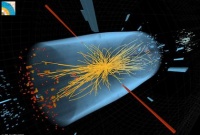 The apparently imminent discovery of the Higgs boson by scientists at CERN will have at least one quirky side effect that appears to have gone entirely unremarked until the appearance of this blog post — it threatens to inflict fatal collateral damage to the brilliant, eccentric and infuriating Omega Point Theory proposed by the physicist Frank Tipler.
The apparently imminent discovery of the Higgs boson by scientists at CERN will have at least one quirky side effect that appears to have gone entirely unremarked until the appearance of this blog post — it threatens to inflict fatal collateral damage to the brilliant, eccentric and infuriating Omega Point Theory proposed by the physicist Frank Tipler.
Tipler, who is not a crackpot, once published a book called The Physics of Immortality, purporting, on the basis of orthodox physics plus some plausible auxiliary assumptions, to establish the existence of an omnipotent, omniscient, omnipresent and altruistic “being” who will one day resurrect everyone who has ever lived to eternal life.
The first step toward that startling conclusion is the assumption that our descendants will not allow all life to come to an end. This in turn will require them to control the evolution of the Universe so that it doesn’t collapse in anything that human beings perceive as a finite amount of time; Tipler argues that they’ll quite plausibly have the technology to do that. But all this future tinkering with the shape of the Universe has consequences that (in a very rough sense) radiate backward and forward through time. From this and some highly technical but more-or-less standard physics, Tipler manages to conclude the existence of an Omega Point — a place where (again speaking roughly) all the information in the Universe is stored. Writing in 1994, Tipler never considered the possibility that the Omega Pont might be located in Mountain View, California. Instead, he stressed that in its omniscience, it’s something very like God.
Not only is the Omega Point omniscient; it’s also ominipotent in the sense that the information located there will allow our descendants to perform feats like resurrecting every one of us from the dead, something that Tipler says they’re sure to do because the cost will be essentially zero. The Omega Point turns out to be not only very like some generic God; it’s very like the Christian God. And the similarities don’t stop there (read Tipler for more).
Alas, Tipler observes in the book that the Omega Point theory also makes a rather specific prediction about the mass of the Higgs boson — it has to be somewhere around 220 gigaelectronvolts (GeV), give or take 10 percent or so. He offers this as a clear test of the theory. And the theory, it seems, is about to fail spectacularly. It looks like the Higgs boson is about to come in at somewhere around 125 GeV.
Tipler’s book had a huge intellectual influence on me, not because of its primary content but because of a tangential remark that triggered my first vision of the Universe as a purely mathematical object, a vision I later learned had been fleshed out by physicists such as Max Tegmark at MIT. Readers of The Big Questions will know that I find this vision extremely satisfying for a great variety of reasons. It provides plausible (to me) answers to a variety of questions that I’d always considered unanswerable, such as “Why is there a Universe in the first place?” Unfortunately, unlike the Omega Point Theory, this is not a vision that can be put to the experimental test.
Tipler’s theory, however, is designed to be put to the test, and if it fails that test (as it’s apparently about to), we should view that as a triumph. Science progresses through predictions so precise that we can know when they’re wrong. Now on to the next theory!
